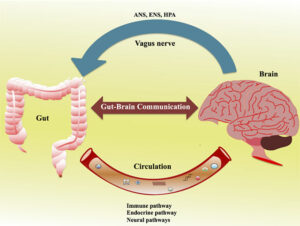YOUR GUT TALKS TO YOUR BRAIN

Source: Suganya, Kanmani, and Byung-Soo Koo
The human brain is truly fascinating. It is so big – three times the size of the brain of our closest relative, the chimpanzee. Why did it evolve to be so much larger, considering that it was so energy-demanding? And why is it so susceptible to dysfunction, for example in states like anxiety, depression and addictions?
These are questions that challenge scientists, public health advocates and philosophers. While we are far from having the answers, we are making progress into how and why.
The idea that your gut ‘talks’ to the brain might seem fanciful (well it did to me!). There are only a few molecules that reach the brain and are capable of influencing its function – glucose being the most important. But the ones making headlines lately are the short-chain fatty acids (SCFAs), the main metabolites produced by bacterial fermentation of dietary carbohydrates (fibre, resistant starch, resistant sugars) in the large bowel (1). They are speculated to have a key role in crosstalk between your microbiome, gut and brain – the so-called brain-gut axis.
About 25 grams of SCFAs are produced in the gut each day depending on the fibre and other carbohydrate composition of the diet. Acetate (with 2 carbons), propionate (3 carbons) and butyrate (4 carbons) are the most abundant SCFAs in the human body, particularly the colon (large bowel/intestine).
While some SCFA are excreted in the stools, most are actually absorbed and used as an energy source. In fact, by some estimates, 10% of all human energy needs are provided by SCFAs. Butyrate is used by the cells lining the colon for their own energy needs and appears to have a powerful inhibitory action against colon cancer. Acetate (the main acid in vinegar) and propionate (commonly added to bread) reach the liver via the portal bloodstream where they can influence liver function and insulin sensitivity.
Only small amounts of SCFA find their way into the systemic bloodstream and circulate throughout the whole body. Via this route, SCFAs can reach the brain where they cross the blood–brain barrier – at least in a cell culture model (2).
Surprisingly, recent research suggests that SCFAs directly influence psychological functioning, including mood and cognition (brain power, thinking clearly), although much of what we know is based on animal models. Studies in mice (3) provide direct evidence of the effects of SCFAs and ketones on psychiatric disorders and psychological functioning, whereas human studies are sparse, and suffer from methodological limitations and inconsistent findings. We are still a long way from sorting out mechanisms.
Much of what we know so far comes from studying the effects of prebiotics, probiotics and diet on psychological functioning and the potential mediating role of SCFA signalling between the gut and the brain. While some studies showed promise of benefit, a recent meta-analysis found no significant overall effects of prebiotics, probiotics and fermented foods on cognitive function (4).
Dietary intervention studies implicate a mediating role for SCFAs in cognition and emotion. The Food & Mood Centre at Deakin University in Melbourne, led by Professor Felice Jacka, is a world-leading, multi-disciplinary research centre that aims to understand the complex ways in which what we eat influences our brain, mood, and mental health. This team of world-class researchers from various backgrounds, studies the food-mood relationship at various levels, from microbiology to public health. Their research aims to identify nutrition-based approaches to preventing and treating mental disorders that may improve brain and mental health.
Finally, meta-analyses suggest that yogurt consumption reduces type 2 diabetes incidence in humans, but the molecular basis of these observations remains unknown. Researchers at Laval University in Quebec Canada and Danone in France have shown that dietary yogurt intake maintains whole-body glucose homeostasis (balance) and prevents insulin resistance and steatosis (fat accumulation) in the liver of a mouse model (5). Faecal transplantation studies revealed that these effects were linked to the gut microbiome.
Furthermore, researchers at the University of Navarra in Spain found that higher intake of high-fat yogurt, but not low-fat yogurt or prebiotics, was associated with a 33% lower risk of depression in women who participated in the SUN Study in Spain (6).
The bottom line
Clearly, your diet influences how you look, think and feel. More important than we ever imagined is our gut health. The reasons relate to the metabolites of the friendly microorganisms inhabiting our large bowel. Don’t take them for granted. Feed them wisely with quality foods that you enjoy.
Read more:
- Miller and Wolin. Pathways of acetate, propionate, and butyrate formation by the human fecal microbial flora. Appl Environ Microbiol. 1996
- Dalile and colleagues. The role of short-chain fatty acids in microbiota–gut–brain communication. Nat Rev Gastroenterol Hepatol, 2019.
- Kimura and colleagues. Short-chain fatty acids and ketones directly regulate sympathetic nervous system via G protein-coupled receptor 41 (GPR41). Proc Natl Acad Sci U S A. 2011.
- Marx and colleagues. Prebiotics, probiotics, fermented foods and cognitive outcomes: A meta-analysis of randomized controlled trials. Neurosci Biobehav Rev. 2020
- Daniel and colleagues. Gut microbiota and fermentation-derived branched chain hydroxy acids mediate health benefits of yogurt consumption in obese mice. Nat Commun, 2022
- Perez-Cornago and colleagues. Intake of High-Fat Yogurt, but Not of Low-Fat Yogurt or Prebiotics, Is Related to Lower Risk of Depression in Women of the SUN Cohort Study123. The Journal of Nutrition,2016
- Deakin University Food and Mood Centre
Emeritus professor Jennie Brand-Miller held a Personal Chair in Human Nutrition in the Charles Perkins Centre and the School of Life and Environmental Sciences, at the University of Sydney until she retired in December 2022. She is recognised around the world for her work on carbohydrates and the glycemic index (or GI) of foods, with over 300 scientific publications. Her books about the glycemic index have been bestsellers and made the GI a household word.








